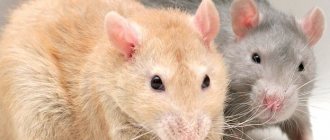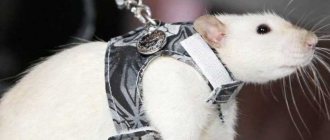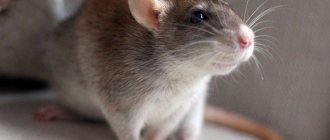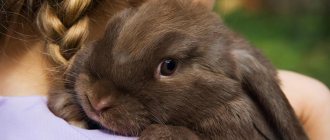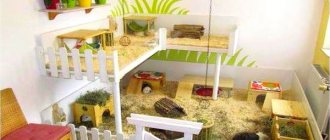Why did rats become pets?
The history of keeping rats by humans dates back to the 19th century, when they were kept for spectacular fights with dogs and for laboratory purposes. In the 1840s to 1860s, rat catcher Jack Black and rat-dog fight organizer Jimmy Shaw began selling rats of interesting colors to keep as pets.
Interest in decorative rats gradually grew and nowadays these smart rodents have become very popular. Organizations and clubs dedicated to decorative rats have been created all over the world; many people choose these particular pets as their companions.
Which breed is better to choose?
Not many people know that among decorative rats there are several varieties. From a genetic point of view, they may well interbreed. But in appearance they differ noticeably. The most common breeds of decorative rats:
- Standard . Forms the basis of other varieties. The size of an adult male is 22-25 cm, weight - 450-500 g. For a female, similar parameters are 20-22 cm and 350-400 g. They are distinguished by a sharp muzzle and oval or triangular ears.
- Dumbo are the cutest rodents. Their main difference is their large, wide-set ears, like the baby elephant in the cartoon “Dumbo.” Hence the name of the breed. In addition, rats of this variety have a more rounded face and a slightly more compact body size.
- Rex, or curly rat . It has not only curly hair, but also curled short mustaches. The pups have slightly disheveled fur, which gives them a very cute appearance.
- Double rex . In addition to the curly fur, it has another feature - rats of this breed are constantly in the process of molting. Therefore, they always have from 1 to 3 bald areas on their body.
- Fuzz . This species is also called the downy rat. Her body is covered with short, sparse down. The pet feels like it's plush to the touch.
- Sphinx . Like Sphynx cats, rats of this breed are hairless. Some individuals have sparse fluff on the face, paws and in the groin area. Sphynx rats are ideal pets for allergy sufferers.
- Husky . They have a characteristic dark mask on their muzzle, making them very similar to dogs of the same breed. These rats look very original. But over time they lighten, and their characteristic pattern becomes almost invisible.
- Tailless . One of the most expensive breeds. Due to the complete absence of a tail, tailless rats have problems with movement and also suffer from diseases of the genitourinary system.
- Albino - better known as a lab rat. The main feature of this breed is the complete absence of coloring pigment in the body cells. This is why albinos have snow-white fur and red eyes.
In fact, there are many more varieties of decorative rats. Which one to choose is up to the future owner to decide. By the way, it is better to choose a pet not according to breed, but according to your liking.
The relationship of decorative rats to humans
Modern decorative rats are harmless to people; many of those who keep these animals note that their pets have never shown aggression towards them. Moreover, unlike hamsters or decorative mice, rats show interest in humans, they interact with humans if they do not offend them. Many of these long-tailed pets are ready to play with their owner for hours and then, tired, fall asleep in the folds of their clothes.
Classification of rats depending on body type
Based on body type, domestic rats are divided into main groups:
- Standard. Pets have a proportional build. They are slender and quite flexible. The size of the tail of decorative rats is almost equal in size to the length of the entire body with head. The shape of the tail tapers from the base to the tip. The eyes of this breed of pet are round and large. The ears are located on top of the head and are proportional in size. The fur of such animals shines slightly and is located throughout the body. Standard rats are the largest ornamental rodents. Their weight ranges from 300-500 grams, directly depending on the animal’s nutrition, as well as its gender. Females are more mobile. Their size from nose to tail reaches about 25 centimeters. Males may be larger.
- "Dumbo" rats. They originated in California. They were brought out in 1991. A distinctive feature of these animals is the structure and location of the ears. In the Dumbo breed they are located lower, not at the very top of the head. The shape is also different. The ears look rounder and wider. In these rats, they can be completely open, and also have a slightly bent upper edge. Some pets have a slightly protruding nape. The body shape of this type of animal widens slightly at the back, resembling a pear. However, the body parameters are smaller than other breeds.
- Tailless rats. The name of these rodents speaks for itself. These animals are characterized by the absence of a tail. Moreover, these animals can be either with or without fur, wavy and curly. The color of the coat is also completely varied. The shape of the body is mainly pear-shaped.
Where can I buy a decorative rat?
You can easily purchase a rat at a pet store, but it is better to purchase it at a specialized nursery, as the animal will cost more, but it will help to avoid many problems in the future.
There is an opinion that rats are tenacious and omnivorous animals, but in fact, rats are prone to many diseases. Treating such a small animal is difficult and quite expensive due to the fact that the courses of treatment are quite long and the medications are expensive. In addition, many veterinarians accept the animals themselves as exotic, which also entails additional costs.
Why you shouldn’t keep different-sex decorative rats together
Decorative rats are collective animals, so they are not kept alone. If an animal is lonely, it experiences stress, which negatively affects its health and life expectancy. Animals of different sexes should also not live together, otherwise they will multiply non-stop. Experienced rat breeders have a negative attitude towards the reproduction of rats outside nurseries, because this primarily harms the rats themselves and their future offspring.
Female or male?
Females are more active, they run, explore the world around them, they will not sit in one place for a long time. Girls are half the size of boys, their fur is softer and smoother. The latter, on the contrary, are twice as large as females, and their fur is hard and oily. Males are much calmer than girls; they can stay on their owner’s shoulder or arms for a long time. Their only drawback is their natural instinct to mark everything around them.
You should not keep young animals of different sexes in the same cage, especially from the same family (young brothers and sisters); such mating can lead to the death of the female or poor offspring.
Basic food for decorative rats
The basis of the rats' diet is grain mixtures. Additionally, animals are fed fermented milk products without sugar, with a fat content of less than 5%, meat, as well as vegetables and fruits. There are nipple and ball drinkers. It is best to purchase the type that the rat used before it became your pet. You should immediately ask the seller about this. If the rat has previously removed its thirst from a bowl, then in addition to the drinking bowl, at first it is worth putting a bowl of water in the cage, because not all rats immediately start drinking from the drinking bowl. As a rule, if one learns to drink from a drinking bowl, others learn very quickly too.
There should always be something to chew on in the cage; it could be a special mineral stone purchased at a pet store, or branches of an apple or cherry tree, doused with steam.
How to feed?
There are many special foods for rats; you can buy them at a pet store. Such sets include wheat, oats, millet, barley, and corn. You can also add various vitamins to your pet’s diet, especially in autumn or winter. They are also sold in the store. The main thing is, when buying an animal, ask the seller what it ate. A radical change in diet will be stressful for the animal.
You can feed them from the table, but with certain foods. It is forbidden to give your rat highly salty, spicy or fatty foods. Vegetables your pet can eat include cucumbers, tomatoes, broccoli, zucchini, and pumpkin. Greens such as dill, cilantro, parsley, basil and celery are good for animals and can be given every day. All citrus fruits should be immediately excluded from the rats' diet due to the acidity. On the contrary, add dairy products: cottage cheese, kefir, fermented baked milk, cheese. Boiled meat is recommended, for example, chicken.
You should not give raw potatoes, beets, cabbage, radishes, or legumes. The feeding regimen is simple, adults need to be given food twice a day, young rats up to three to four times.
The main thing is the presence of clean drinking water in the cage. It must be changed every day or every two days.
What to do before buying a rodent
You need to prepare for the appearance of a rat in advance so that the animal does not experience unnecessary stress and does not sit in a box while you are looking for a cage. You need a large cage, at least 1.2 m3 per animal. It is better to look for such “living space” among cages for ferrets, chinchillas, and rabbits.
The distance between the rods should be about one centimeter, more is possible, but only for adult and large rats, otherwise your pet will constantly escape from the cage. To keep females, it is better to choose tall cages, that is, those where height prevails over length; girls love to climb. Male rats are more clumsy and lazy; for them it is better to choose a cage that is not high, but long.
Keeping a rat - what to budget for?
Expenses are not limited to purchasing an animal. It is necessary to purchase a fairly spacious cage, specifically designed for rodents, which will cost from 500 to 13 thousand rubles. You can choose a container for food from those you have at home, but it is better to buy an automatic drinking bowl. It costs from 130 to 500 rubles.
It costs almost as much to keep a rat as the rat itself.
You also need bedding, which should be changed quite often. It will cost from 2 to 50 rubles per kg, depending on the type. You can make a house for an animal yourself from a small box or plastic. It’s quite easy to make on your own all kinds of exercise equipment and toys that the animals can use to keep themselves busy.
Choosing a diet - how much does it cost to feed an animal?
Regular human food is not suitable for rodents. They need their own diet. You can solve your nutrition problem by creating your own menu for animals. This is the cheapest option. But in this case, you should strictly follow the recommendations of specialists so that the animals receive all the necessary substances.
You can take the easier, but also more expensive, route by purchasing rat food in the store. Prices for such food vary greatly. You can find food for both 100 and 1,000 rubles per kilogram. It all depends on the manufacturer and quality class.
When can you let your rat out for a walk?
Decorative rats should be let out of their cages for a walk; if the animal has been in your house for a long time and you have taken good care of it, then believe me, it will not rush under the nearest closet. It will be very interesting for you to watch how the rat explores “new horizons”. The main thing is to keep away wires and electrical appliances, as well as objects that a rat can try.
Who is better to choose, a boy or a girl?
Males and females of the decorative rat are noticeably different from each other. And not only in terms of physiology. The character of pets of opposite sexes also varies greatly. Distinctive features of female rats are:
- Activity . Females are constantly busy with something - playing, practicing on apparatus, grooming.
- Attachment to the owner . Girls are more affectionate. They require constant attention and love to be held and petted.
- Curiosity . Female rats are constantly looking for something, sniffing it, testing it. These little explorers are always ready to discover new horizons.
Boy rats have other characteristic features:
- Laziness . Males prefer a quiet rest in a cozy house or hammock to active games. They, of course, are also not averse to a little frolic, but only sometimes.
- Aggression . Males, especially during puberty, often sort things out with their cage neighbors. This is how they try to strengthen their position in the “pack” and gain the attention of females.
- Gluttony . Boys of decorative rats are ready to eat everything without stopping. The main thing is not to follow their lead and not to overfeed. Otherwise, your pets will experience gastrointestinal upset.
It is also worth noting that if the future owner of decorative rats plans to breed animals, he will need individuals of both sexes. Only, of course, they will have to be kept in different cages.
Many people choose females only because of the very prominent testes of male rats. Some solve this issue by castration.
Important notes before purchasing a rodent
When choosing a rat, you should pay attention to the animal’s activity and its interest in the world around it. If an animal hides in a corner and looks detached, then it most likely has health problems. The new pet's coat should be thick and shiny, without bald spots. Scratching too often is a sign of skin problems. The rat's breathing should be smooth, almost imperceptible. If a pet candidate breathes heavily, with whistling or wheezing, it is better to abandon him.
Ratmaniya
Where, whom and how.
Photo of Miele, author Svetlana Levashova
And now you have decided or are just about to get a little rat. Accordingly, one of the questions that arises is where to buy a rat, how and whom to choose?!
Let's start in order. Rats should be with their mother for up to 5 weeks - this has a beneficial effect on their health, mental state, development and attitude towards the world around them. The mother rat not only feeds the babies, laying the foundations for immunity and health, but also teaches them some worldly wisdom: communicating with people, the ability to eat different foods, and how to behave in different situations. Therefore, you should not adopt a baby rat less than five weeks old. The extreme case is 4 weeks. It is also necessary to pay attention to the age of the parents: the mother should be at least 7 months old, and the father 8 - this also affects the health of the rat pups.
When choosing, first of all, you should pay attention to the appearance of the animal. A healthy animal behaves calmly, it is inquisitive and nimble. The coat looks smooth, shiny and without bald spots. There is no discharge, crust or inflammation on the eyes and nose. You should not take an animal that sneezes, because... sneezing is the first sign of colds and infectious diseases. It is also advisable to take a closer look at the child’s behavior: the little rat should respond adequately to people, not be aggressive, and show curiosity and interest in people. You can also see possible health problems from their behavior: rat pups with poor eyesight can make characteristic body movements, the so-called “snake behavior” - i.e. move your head from side to side, which is similar to the movements of the head of a snake (which is normal for rats with red eyes, note VaKa).
Now let's talk about where to buy a rat. There are a lot of options: nurseries, breeders, clubs, pet stores, markets, etc. Let's look at each of them. The nursery, breeder and club are equally good - for the most part, animals purchased in such places will be properly raised, trained to handle and have a pedigree. It is advisable to choose nurseries, clubs and breeders with extensive experience, and first find out information about them from independent sources. These same options can provide a certain guarantee of health and the absence of other problems. For example, early pregnancy, which can be encountered if you buy a female rat in a pet store or at the market. After all, rats are very precocious and at five weeks the pups must be seated separately by gender, which is not always done in stores and markets.
In addition to early pregnancy, when buying rat pups in pet stores, markets and other dubious places, you may encounter a wide variety of diseases, behavioral problems and parasites. Also, by buying animals in such places, you stimulate uncontrolled breeding, without following the rules (mating too young and too old animals; frequent births; mating of obviously sick animals).
Don’t forget that if you buy a baby rat at the market, you risk losing it a few weeks after purchase...
He or she.
When choosing a little rat, another question arises: who to choose, a boy or a girl? Let's look at both options!
- Female . Girl rats are usually noticeably smaller than boys (on average about 300-400 g, while boys can grow up to 1 kg). They are more nimble and playful, restless and curious. If you have two or more girls, neither they nor you will be bored. However, there are several BUTs that are definitely worth thinking about: firstly, girls are more susceptible to tumor diseases (for example, mammary tumors), and secondly, estrus in female rats occurs every 5-10 days, which can lead to accidental matings , if you already have male rats or wild rats at home. Thirdly, owners of girls (and not only rats - this also applies to dogs, cats, and other animals) often begin to talk about the benefits of mating. “One time for health”, “placement for children is not a problem” - this can be heard even from veterinarians. Believe me, this is not true! No animal has ever lost the joy of life because it never gave birth. Imagine what it’s like to raise 15 or even more little children! Not to mention the possible difficulties and complications during pregnancy, childbirth and feeding. And even if you do decide to have offspring, you should be very careful when choosing a potential groom for your rat, because baby rats are not only a huge responsibility for their future, but also a huge risk for the health of your pet.
- Male . A large, imposing, sedate beast. With him there will be no girlish games with running and jumping - he is too serious for such things. Of course, there are exceptions, but for the most part, a rat is a creature that would rather lie in your arms than play active games with you. From the BUT, it is worth mentioning the fact that it will be more difficult to place someone with a boy in the future (or even impossible), and also the fact that if you have several boys, then with age they can quarrel among themselves (up to serious injuries).
In general, both have their pros and cons, so in the end it’s up to you to choose, but they’re all good.
Author Milanovic Elizaveta aka Puma
- Where to buy a rat? So, it’s decided, for complete happiness you need rats or another new rat for expansion...
- How much does a kitten rat cost? The question of the cost of baby rats worries not only potential buyers, but also often strangers. Some people just...
- About breeders and breeders Decorative rats are inexpensive, they are quite easy to keep, and they, in general, breed on their own, even...
Habits of rats
Rats are very cheerful animals, many of them are like kittens, they love to run after a string and wrestle with their owner’s brush. But when playing, it’s worth remembering that these pets are smaller than you and you need to handle them carefully. If you are buying an animal for a child, it is worth explaining and showing him how to handle a new family member, as well as being present during the child’s first contacts with a rat.
If you are still in doubt whether to get a decorative rat or not, then think carefully. Indeed, despite the small size of this animal, a decorative rat needs no less care than a cat or dog.
One or more?
We were not ready for offspring and did not plan to breed rats, so we bought two females. In nature, rats live in groups. If the owner is away from home for a long time, it is better to get a couple of animals. Otherwise, you need to be prepared to devote a lot of time to your pet. It is worth taking a couple of approximately the same age and from the same family - sisters or brothers.
We bought Nebula and Gamora in the summer of 2022, they were a month old. This is the ideal age of the rat at the time of purchase - from one month to one and a half months. During this time, the animal receives the necessary skills from its mother, but at the same time it is still easy for it to get used to its new owner.
